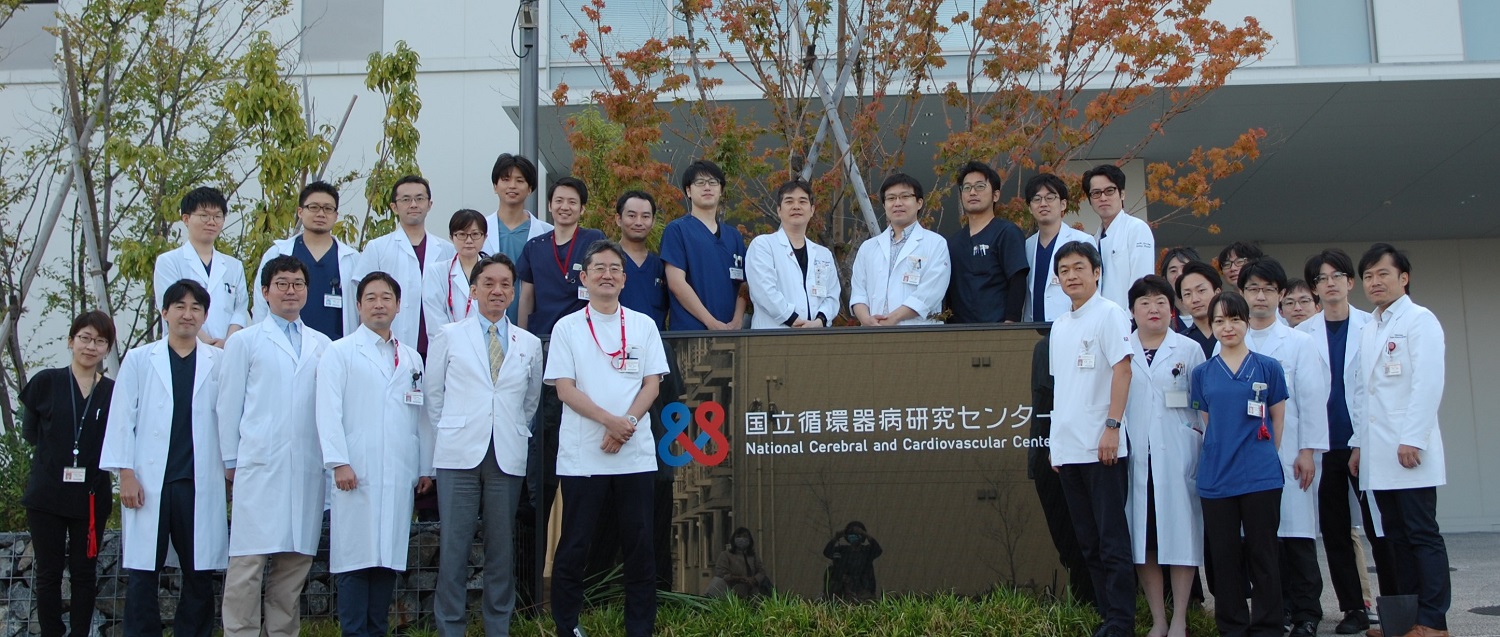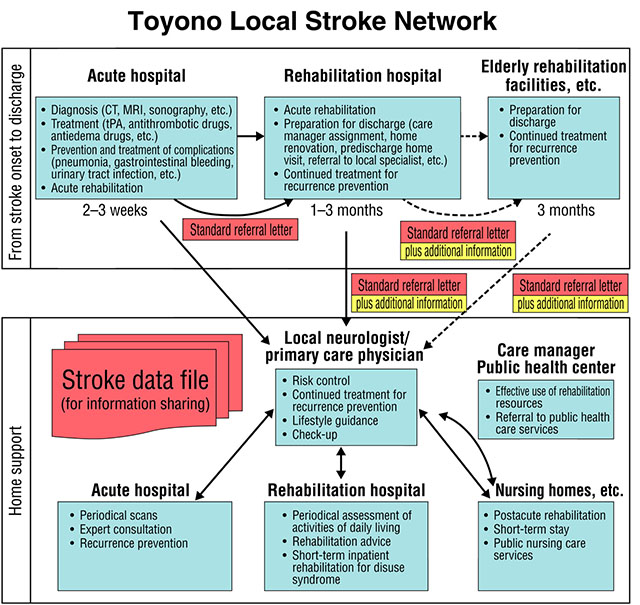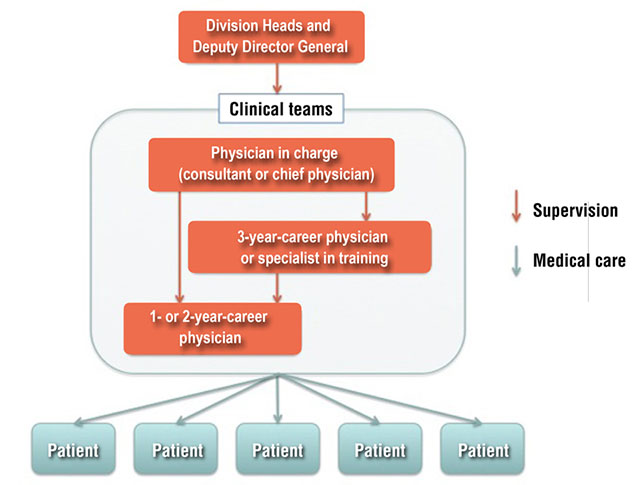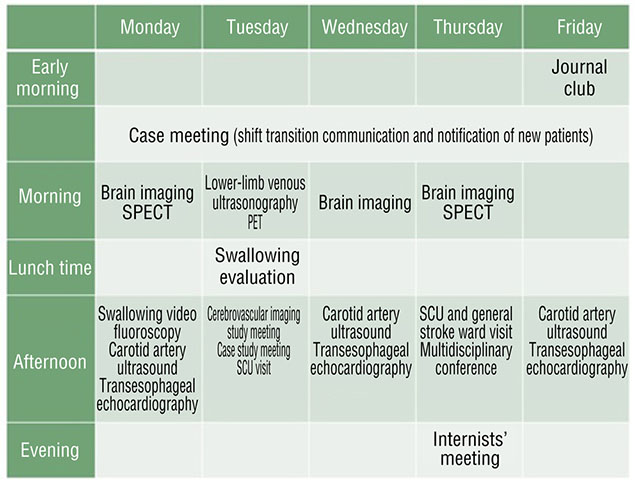Division of Cerebrovascular Medicine and Neurology
To medicalstaff
- Clinical Team: Cerebrovascular Medicine (Brain medicine A)
- Clinical Team: Neurology
(Brain medicine B)

【photo taken October 13, 2020】
1. Scope of Clinical Practice
a. Introduction
The Division of Cerebrovascular Medicine and Neurology regards stroke as a systemic vascular disorder and takes an integrated treatment approach involving neurology, cardiovascular medicine, emergency medicine, the science of thrombosis and hemostasis, and rehabilitation medicine.
All patients who have a stroke require specialty care. Until recently, the general public and even some physicians considered stroke as an incurable disease with no available effective treatment. That misconception prevented many stroke patients from receiving the medical attention they deserved. Our Division started in 1977 as one of the few units dedicated to stroke treatment and care in Japan at that time. In 1978, the Stroke Care Unit (SCU) was established to provide intensive acute stroke care. With the increasing popularity of intravenous tPA therapy and SCUs in Japan, more and more people are beginning to believe that stroke is curable.
With a motto to "beat stroke,"we are committed to clinical practice as a regional hub stroke center. Our efforts will help shape the national and international standards of stroke care.
b. Staff
As of December 2011, our Division has 41 physicians, consisting of one Deputy Director General, three division heads, five chief physicians, seven physicians, five specialists-in-training, and 20 junior trainee physicians. These physicians are divided into two groups: A and B. Both groups are committed to stroke diagnosis, treatment, research, and education and provide the latest in medical services.
c. Clinical Services
We provide medical care for strokes and related neurological disorders. Outpatient services are available in the morning and afternoon from Monday through Friday. Patients visiting our Division for the first time are seen by a head or chief physician. Return-visit patients are taken care of in the specialty outpatient clinic that hosts four full-time physicians. To address emergency situations, three physicians are on call around the clock throughout the year.
Our Division emphasizes the latest techniques for stroke care. Acute stroke patients are admitted to the SCU to identify the cause of the problem and receive intensive treatment. The NCVC Hospital's SCU comprises 23 beds. This capacity is large enough to accommodate acute patients at any time.
When their condition stabilizes after SCU treatment, patients are transferred to the general stroke ward (approximately 80 beds) and start postacute therapy in preparation for discharge. Postacute therapy includes rehabilitation exercises and management of risk factors (e.g., hypertension and diabetes mellitus). NCVC Hospital serves as a hub stroke center for Toyono Region, Osaka. The coordination and partnership of stroke-related service providers allow for a seamless array of health care services ranging from acute treatment to in-home support, as shown in Figure 1. Moreover, we identify patients who need surgical treatment (e.g., invasive operation or endovascular therapy) and refer them to the Division of Neurosurgery without delay.
Figure 1.

From admission to discharge, one patient will be cared for by a team of three physicians. Individual clinical teams comprise (i) a leading physician (consultant or chief physician), (ii) a 3-year-career physician or specialist in training, and (iii) 1- or 2-year-career physician. One team is responsible for approximately 10 patients (Figure 2). Team members visit their patients every day for monitoring, treatment, and follow-up care.
Figure 2.

Every morning, staff members of the Division get together to discuss appropriate management of the patients admitted the previous day. Then, they are divided into teams to start their practice for the day. Division head physicians visit all SCU patients every Tuesday. On Thursdays, Division head physicians (or Deputy Director General) lead multidisciplinary conferences after visiting all patients in the SCU and general stroke ward. The conferences include rehabilitation workers, nurses, and social workers. On Tuesdays physicians gather and discuss case studies using cerebrovascular scan images to improve their diagnostic accuracy. They also discuss the management of treatment-refractory patients.
Figure 3.

2. Admission Criteria and Patient Referral Procedure
- Transient Ischemic Attack (TIA) Care at the NCVC Hospital
- Comprehensive Superacute Stroke Care that Includes Intravenous tPA and Endovascular Therapies
3. Clinical Teams
- [Brain Medicine A]
- [Brain Medicine B]
<!--
-->
last updated : 2021/11/25
